Faculty of Science
Mathematics
Linear Algebra
Linear Algebra with Applications: Lyryx
By: W. Keith Nicholson
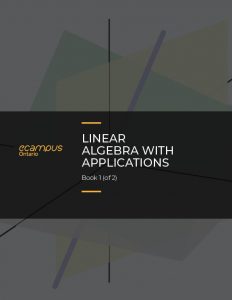 The first version of this textbook was published in 1986 as a traditional textbook. The current version from 2018 was published as an open educational resource for a traditional or advanced introduction to the topics within linear algebra.
The first version of this textbook was published in 1986 as a traditional textbook. The current version from 2018 was published as an open educational resource for a traditional or advanced introduction to the topics within linear algebra.
Includes: instructor resources: solution manual to exercises and lecture slides.
Attribution: Linear Algebra with Applications: Lyryx by W. Keith Nicholson is licensed under a Creative Commons Attribution Non-Commercial ShareAlike 4.0 International License.
Linear Algebra
By: Jim Hefferson, St. Michael’s College, Vermont
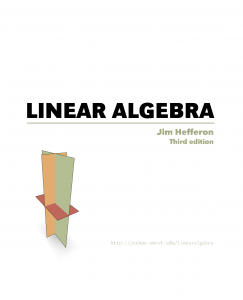 This textbook, now in its fourth edition, has been positively reviewed by four math professors from American universities and the Mathematical Association of America.
This textbook, now in its fourth edition, has been positively reviewed by four math professors from American universities and the Mathematical Association of America.
Includes: exercises, solutions, a lab manual, lecture slides, and includes applications of linear algebra.
Attribution: Linear Algebra by Jim Hefferson is licensed under the GNU Free Documentation License and a Creative Commons Attribution-ShareAlike 2.5 License.
Calculus for Life Sciences
Differential Calculus for the Life Sciences
By: Leah Edelstein-Keshet, University of British Columbia
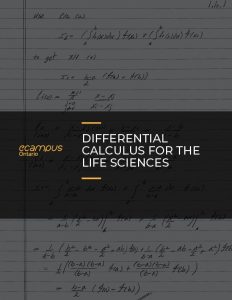 This textbook was written by a math professor at the University of British Columbia and is currently used as a textbook for introductory calculus courses for life sciences undergraduates.
This textbook was written by a math professor at the University of British Columbia and is currently used as a textbook for introductory calculus courses for life sciences undergraduates.
Includes: exercises and solutions to selected problems.
Attribution: Differential Calculus for the Life Sciences by Leah Edelstein-Keshet is licensed under a Creative Commons Attribution Non-Commercial ShareAlike 4.0 International License.
Calculus for the Life Sciences: A Modelling Approach Volume 1
By: James L. Cornette and Ralph A. Ackerman, Iowa State University
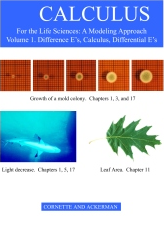 This textbook was written by two professors at Iowa State University with the goal introducing students to scientific modeling. This course aims to teach students the necessary skills and concepts from a traditional physical sciences course, while explaining the applications of calculus to the life sciences.
This textbook was written by two professors at Iowa State University with the goal introducing students to scientific modeling. This course aims to teach students the necessary skills and concepts from a traditional physical sciences course, while explaining the applications of calculus to the life sciences.
Includes: exercises, solutions to select problems, and MATLAB exercises.
Attribution: Calculus for the Life Sciences: A Modelling Approach Volume I by James L. Cornette and Ralph A. Ackerman is licensed under a Creative Commons Attribution Non-Commercial No Derivatives 4.0 International license.
Calculus
Calculus: OpenStax Volumes 1-3
Volume 1 concepts: functions, limits, derivatives, and integration
Volume 2 concepts: integration, differential equations, sequences and series, and parametric equations and polar coordinates
Volume 3 concepts: parametric equations and polar coordinates, vectors, functions of several variables, multiple integration, and second-order differential equations
Includes: Exercises and answers. Volume 1 has been faculty-reviewed, adopted, is accessible, and has ancillary resources. Volume 2 has been adopted, has ancillary resources, and is accessible. Volume 3 is accessible and has ancillary resources. Adopt and adapt these volumes at the links above on Volumes 1, 2, and 3, respectively.
Active Calculus Single Variable
By: Matthew R. Boelkins, David Austin and Steven Schlicker
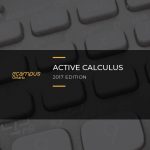 Active Calculus is different from most existing calculus texts in at least the following ways: the text is freely readable online in HTML format and is also available for in PDF; in the electronic format, graphics are in full color and there are live links to java applets; there are live WeBWorK exercises in each chapter, which are fully interactive in the HTML format and included in print in the PDF; the text is open source, and interested users can gain access to the original source files on GitHub; the style of the text requires students to be active learners — there are very few worked examples in the text, with there instead being 3-4 activities per section that engage students in connecting ideas, solving problems, and developing understanding of key calculus concepts; each section begins with motivating questions, a brief introduction, and a preview activity, all of which are designed to be read and completed prior to class; following the WeBWorK exercises in each section, there are several challenging problems that require students to connect key ideas and write to communicate their understanding
Active Calculus is different from most existing calculus texts in at least the following ways: the text is freely readable online in HTML format and is also available for in PDF; in the electronic format, graphics are in full color and there are live links to java applets; there are live WeBWorK exercises in each chapter, which are fully interactive in the HTML format and included in print in the PDF; the text is open source, and interested users can gain access to the original source files on GitHub; the style of the text requires students to be active learners — there are very few worked examples in the text, with there instead being 3-4 activities per section that engage students in connecting ideas, solving problems, and developing understanding of key calculus concepts; each section begins with motivating questions, a brief introduction, and a preview activity, all of which are designed to be read and completed prior to class; following the WeBWorK exercises in each section, there are several challenging problems that require students to connect key ideas and write to communicate their understanding
Includes: interactive exercises and solutions, a lab manual, and other instructor resources.
Attribution: Active Calculus Single Variable by Matthew R. Boelkins, David Austin and Steven Schlicker is licensed under a Creative Commons Attribution Non-Commercial ShareAlike 4.0 International License.
Active Calculus Multivariable
By: Matthew R. Boelkins, David Austin and Steven Schlicker
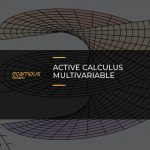 In Active Calculus – Multivariable, we endeavour to actively engage students in learning the subject through an activity-driven approach in which the vast majority of the examples are completed by students. Where many texts present a general theory of calculus followed by substantial collections of worked examples, we instead pose problems or situations, consider possibilities, and then ask students to investigate and explore. Following key activities or examples, the presentation normally includes some overall perspective and a brief synopsis of general trends or properties, followed by formal statements of rules or theorems. While we often offer plausibility arguments for such results, rarely do we include formal proofs. It is not the intent of this text for the instructor or author to demonstrate to students that the ideas of calculus are coherent and true, but rather for students to encounter these ideas in a supportive, leading manner that enables them to begin to understand for themselves why calculus is both coherent and true
In Active Calculus – Multivariable, we endeavour to actively engage students in learning the subject through an activity-driven approach in which the vast majority of the examples are completed by students. Where many texts present a general theory of calculus followed by substantial collections of worked examples, we instead pose problems or situations, consider possibilities, and then ask students to investigate and explore. Following key activities or examples, the presentation normally includes some overall perspective and a brief synopsis of general trends or properties, followed by formal statements of rules or theorems. While we often offer plausibility arguments for such results, rarely do we include formal proofs. It is not the intent of this text for the instructor or author to demonstrate to students that the ideas of calculus are coherent and true, but rather for students to encounter these ideas in a supportive, leading manner that enables them to begin to understand for themselves why calculus is both coherent and true
Includes: exercises and solutions.
Attribution: Active Calculus Multivariable by Matthew R. Boelkins, David Austin and Steven Schlicker is licensed under a Creative Commons Attribution Non-Commercial ShareAlike 4.0 International License.
Community Calculus (Single, Multivariable)
This online compilation of four calculus textbooks is frequently updated and has been used in courses. It has been positively reviewed by the Mathematical Association of America. It also covers early and late transcendentals.
Includes: exercises, solutions, and WeBWorK problem sets.
APEX Calculus
This text, or portions of it, has been adopted at a considerable number of American institutions to teach calculus, according to their website. These institutions include the Virginia Military Institute, where the author is an associate professor of mathematics.
Includes: interactive graphics, exercises and solutions.
Contemporary Calculus
This textbook was created as part of the Washington State Colleges’ Open Course Library Project, which received funding through the Gates Foundation. This text has been used by thousands of students within Washington State and was developed by a professor at Bellevue College.
Includes: exercises, solutions to odd-numbered problems, and other resources.
Calculus
By: Gilbert Strang
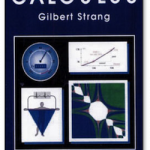 Originally published through traditional means, this textbook is now available as an open educational resource. This text includes single and multivariable calculus and was written by a professor of mathematics at the Massachusetts Institute of Technology.
Originally published through traditional means, this textbook is now available as an open educational resource. This text includes single and multivariable calculus and was written by a professor of mathematics at the Massachusetts Institute of Technology.
Includes: an instructor’s manual, a student study guide with exercises and select solutions, and links to a calculus video series by the author.
Attribution: Calculus by Gilbert Strang is licensed under Attribution-NonCommercial-ShareAlike
Statistics
Introductory Statistics: Saylor
By: Douglas S. Shafer and Zhiyi Zhang
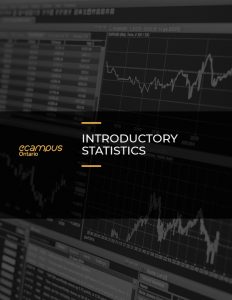 This peer-reviewed resource introduces statistical concepts, including: descriptive statistics, basic concepts of probability, discrete random variables, continuous random variables, sampling distributions, estimation, testing hypotheses, two-sample problems, correlation and regression, and chi-square and f-tests.
This peer-reviewed resource introduces statistical concepts, including: descriptive statistics, basic concepts of probability, discrete random variables, continuous random variables, sampling distributions, estimation, testing hypotheses, two-sample problems, correlation and regression, and chi-square and f-tests.
Includes: exercises and answers.
Attribution: Introductory Statistics by Douglas S. Shafer and Zhiyi Zhang is licensed under a Creative Commons Attribution Non-Commercial ShareAlike 4.0 International License.
If you have questions about Open Educational Resources or other Open resources in your subject area, please contact your subject liaison librarian.

